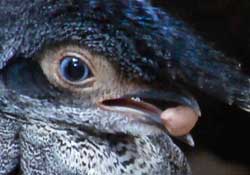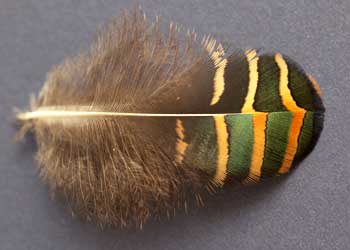
Exotic Feathers
Last Update - Sunday, November 11th, 2012
I have been interested in exotic feathers for as long as I can remember. Each summer the birds go into a molt and it seemed such a shame to throw away such rare feathers
Finding good quality classic fly tying materials is increasingly difficult. Imports from Asia have all but been cut off.
Here you will find everything from single feathers, to perfectly paired sets, to full skins. Not everyone can afford or even have use for a full skin so I've put together feather assortments for most species.
Any guesses what bird this is from?
Ordering
Below is a list of feathers that I have in stock. Some have links that will take you to the page and you can order there. Keeping everying current on the site is hard. So from here on out, for the rest, to place an order, please either call, text, or email for pricing and avalability. Texting is best!
David
608-332-4220
Exotic Feathers - links
Here is the most extensive list of exotic feathers for tying full dressed atlantic salmon patterns you will find anywhere.From perfectly matched pairs to full skins, you'll find it all here!
Pheasants | Grouse | Partridge | Quail | Francolins & Spurfowl
Junglefowl | Guineafowl | Peafowl
Turkey | Bustards | Cranes & Storks | Waterfowl | Hookbills | Softbills | Pigeons & Doves | Ratites
Ordering: Many of these pages are not set up with a shopping cart... I'm still working on that. But dont let that stopyou, if you see a picture of it - it is in stock and for sale! So please call in your order. David 608-332-4220
All pheasants are native to Asia. There are 52 different breeds of these beautiful birds, 17 of which are listed as endangered.
Habitat destruction and hunting has reduced the number of these birds in the wild. The Hainan Peacock Pheasant, thought to be a subspecies of the grey, is one of the most endangered birds in all of China. Today it is at greater risk of extinction than even the Giant Panda.
| Tragopans, Koklass, & Monals |
| Satyr Tragopan | Temmink's Tragopan | Cabot's Tragopan Koklass Impeyan (Himalayan Monal) |
| Gallo pheasants |
| True Silvers | Lewis Silver | Anderson's | Crawfurd's / Lineated Kalij | Dark Feathered Kalij Crestless Firebacks | Crested Firebacks |
| Long-tailed & True Pheasants |
| Reeve's | Coppers | Ringneck |
| Ruffed & Eared Pheasants |
| Golden | Lady Amherst | Blue Eared |
| Peacock Pheasants |
| Great Argus | Grey | Germain's | Rothschild's | Malayan |
| Cross-breeds |
| Am-gold | Amherst / Reeves | Silver / Reeves |
| top |
There are 43 different breeds of partridge, some dull in color such as the rock partridge while others such as the crimson-headed partridge is among the brightest colored of any bird. They are native to Europe, Asia, Africa, and the middle East. Not to confuse them with grouse, partidge are clean legged, having no feathers on their legs or feet.
|
Hungarian | Chukar | French Red-legged (Barbary) | Bamboo | Crested Wood | Philby's Rock |
| top |
This is a family of cold weather birds, all 23 species of grouse evolved in the pine forest, moorlands, mountain sides, and grasslands of the northern hemisphere; all between the 28 North and 83 North Parrelel. Their legs and feet are feathered for protection.
|
| North American |
| Ruffed | Spruce | Sharp-tailed | Blue | Prairie Chicken | Sage |
| European |
| Red | Black | Capercaillie | Hazel |
| top |
The family of quail is divided up into Old World, (Europe, Africa, and Asia) and New World, (the rest of the world) species. Old World species are in the pheasant family while the New World species, 32 in nine genera, are in a family of their own.They are found to inhabit a wide variety of terrain ranging from the tropical rain forest of Asia and South America to the deserts of Africa and North America. However, unlike grouse, few species are able to tolerate extreme cold.
|
| Bobwhite | Gambel | California Valley | Blue Scaled | Mountain | Mearns |
| top |
Related to the pheasant family, the genus francolinus is a very vocal family of terrestrial birds consisting of 40 members, 5 in Asia and the rest in Africa. Some are refered to as "Francolins" and others as "Spurfowl", depending on how they are classified. Hardy, they are well adapted to cultivated crops. The Grey Francolin is considered to be a scrappy bird and often used for fighting
|
| Black | Grey | Chinese | Yellow-necked | Red-necked | Erkel's |
| top |
All chickens are genetic descendents of the red junglefowl. Today there are 56 recognized lines of fancy show breeds, domesticating this bird and selecting for all the different breeds took hundreds if not thousands of years. However, if we took all lines of fancy chickens and bred them back together, we would end up unraveling all those years and be right back with a red junglefowl.
|
| Grey Junglefowl| Green Junglefowl | Red Junglefowl | Ceyon Junglefowl |
| top |
All 6 species of guineafowl are native to Africa. With the exception of the helmeted and vulturine, they are predominatly forest birds. Only the hemeted has been domesticated and today is commonly seen around farm buildings. They can't be missed, just the slightest concern will set them off chattering hysterically.
|
| Vulturine | Helmeted | Kenya Crested | Zambizi Crested | Domestic Lines |
| top |
In their pure form there are only 3 species of peafowl; the blue, the green, and the congo. In captivity however, breeding enthusiasts have created close to 225 color mutations that range from white to a very dark colored bird called "midnight". Coming up with names for new colors is as difficult as coming up for names for new paint colors.
|
| India Blue Peafowl | Java Green Peafowl | Designer Peafowl |
| top |
The name "turkey" was given to these fabulous birds, somewhat incorrectly, by Europeans who first imported them from the new world through the country of Turkey. Mistaking them as a type of Guineafowl, they called them "Turkey fowl" which was later shorted up to just "turkey". And as with peafowl, breeders have selectivly bred them into every size, shape, and color.
|
| Wild Turkeys | Ocellated Turkey | Dyed White Turkey | Heritage Turkey Ocellated / Wild Turkey Cross |
| top |
After more than 150 years, the Great Bustard is again nesting in Britain. Not since 1832 had a nest been recorded and now with birds introduced from Russia, the heaviest bird capable of flight is back. There are 26 different species of bustards. They are an Old World family that diverged from cranes some 70 million years ago. Stately in appearance, these birds find their home in the dry open country and steppes of Europe, Asia, Africa, and Australia. Unfortunately, due to hunting and habitat loss, populations of most species are in danger . The heaviest recorded weight of a Great Bustard to date is 46 pounds. |
| Florican Bustard | Kori Bustard |
| top |
Even though there are only 15 species of cranes, these elegant birds can be found on every continent except Antartica and South America. Most species are at least threatened if not critically endangered so this limits the species that can be offered here. These are all captive raised birds.
|
| African Crowned | Stanley (Blue) | Demoiselle Chinese Pond Heron | Tiger Heron |
| top |
The buying, selling, trading, and bartering of native migratory waterfowl is regulated at the federal level by the Migratory Bird Treaty Act. This covers both "webbed" and "non-webbed" birds. Trade in all non-webbed species is forbidden while trade in webbed species is allowed but only feathers intended to be used for fly tying or millinary purposes. Added to this is state law. Most defer to the federal statute, however, a few states, and Wisconsin is one, are more strict, forbidding trade in feathers harvested from the wild. Hence, the feathers listed below are collected from captive bred birds and the proper 3-186 tranfer paperwork is on file and available.
|
| North American |
| Wood Duck | Northern Pintail | Gadwall | Green Winged Teal | Mallard | Hooded Merganser Northern Shoveler | American Wigeon | Blue Winged Teal |
</
| Non Native Species |
| Mandarin | Falcated Teal | Ring Teal | Baikal Teal | Gargany Teal | White Faced Tree Duck |
| top |
Hookbills refers to any parrot type bird including macaws, cockatoos, conures, paarakeets, etc. They are some of the most colorful birds in nature and range greatly in size. Unfortunatly, many breeds are listed on the Endangered Species Act (ESA) and as such, are not listed here for sale.
|
| Parrots | Macaws | Parrakeets Black Cockatoos | White Cockatoos Conures | Lorys | Lorikeets |
| top |
Whoever named this group of birds "softbills" was obviously never close enough to be pinched by a toucan or speared by a heron's beak!
|
| Indian Crow | Blue Cotingas | Pompador Cotinga Cock-of-the-Rock | Magnificent Rifflebird Fairy Bluebird | Golden-Breasted Starling | Common Starling | Flamed Tanager | Eurasian Jay Toucan Asian Kingfisher | African Kingfisher Sunbittern |
| top |
The difference between pigeons and doves? Only size. They all belong to the family Columbidae that includes some 300 species. There is considerable variation in size, crown pigeons of New Guinea being the largest, while the Dwarf fruit dove is the smallest. With the exception of the Sahara Desert, Antartica, and the Artic, these birds can be found everywhere on Earth with the greatest variety found in the Indomalay and Australasia ecozones.
|
| -coming soon |
| top |
Ratites are a family of mostly flightless birds. They differ from other bird groups in that they have no keel or sternum. This is the large bone that the flight muscles are anchored to so a bird can fly. You'll find them on almost every continent. In Africa there is the Ostrich, in Australia the Emu, in New Zealand the Kiwi, in New Guinea the Cassawary, and lastly, in South America the Rhea and Tinamou.
|
| Ostrich | Rhea | Emu | Cassawary |
| top |
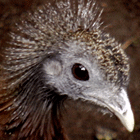
Argus Hen

Malayan Great Argus
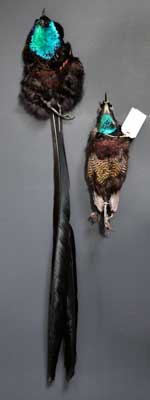
Princess Stephanie's
Astrapia
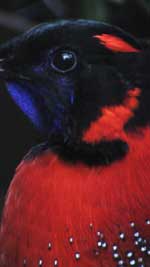
Satyr Tragopan
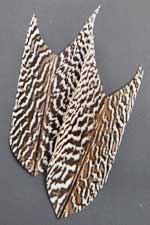
Silver Pheasant
Hen Tails
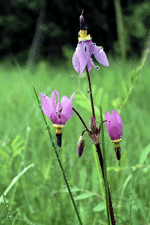
Shooting Star
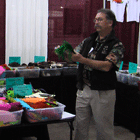
Chuck Furimski shops only the best!
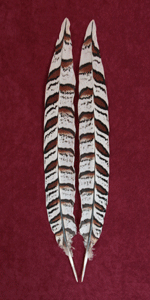
Silver Reeves Cross
Grey Junglefowl
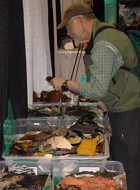
Shopping
True Silver Pheasant
Red Grouse

Mayfly
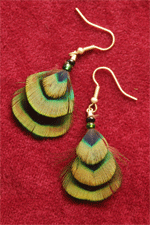
Java Green Neck Feathers
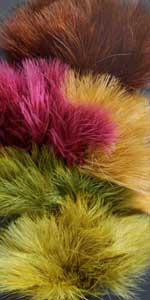
Marabou - Strung Blood Quills
Malay Crestless Fireback
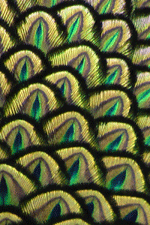
Java Green Peacock
Tiger Heron

Waterfowl Flank Feathers
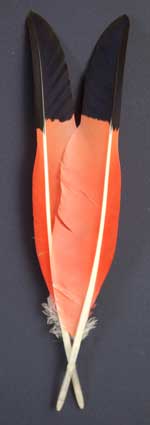
Scarlet Ibis Wing Quills
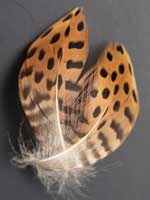
Australian Shoveler
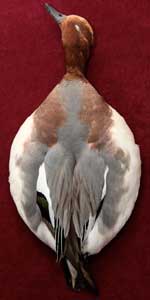
European Wigeon
Cotinga
White Breasted Kingfisher
Red Junglefowl
Temmink's Hen
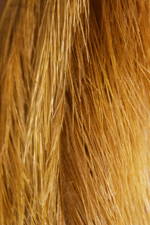
rhea - golden olive
